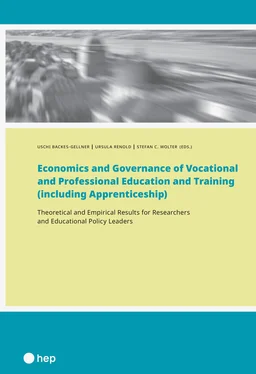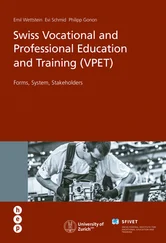Because it is difficult to capture VET programs’ peculiarities without understanding the interplay of actors and institutions, to solve fundamental problems (Turner, 1997), it is necessary to develop a theoretical and methodological concept that helps to identify comparable functions in VET processes. By explaining the theoretical foundations of the different construct forms, Sismondo (1993) took a necessary step towards understanding socially constructed concepts. However, it is not sufficient to compare VET programs and understand their proper functions without a profound theoretical understanding of social institutions and their field-specific application. Renold et al. (2019)developed a theoretical and methodological framework based on theoretical foundations and conceptual derivations of institutionalism theory to measure the robustness of social institutions and provide a field-specific theoretical approach for applying the generic framework to social institutions in education and training. The authors hypothesized that robust social institutions are robust in all properties (function, structure, culture, sanction) and dimensions (temporal and spatial) and that robust VET programs are composed of individual robust social institutions. The limitations of the authors’ approach lie in the fact that empirical results are not yet available that can show what the interplay of institutions and actors looks like in various real programs. However, their framework provided a theoretical framework necessary to capture socially constructed concepts.
Type b) applies to social constructs that are used in empirical research. If researchers are unaware of the different socially constructed concepts behind data, the results can be misleading. The empiricist construction metaphor addresses the construction of “images, accounts, or theories given the data” (Sismondo, 1993, p. 516). Van Fraassen (1980) summarized construct empiricism as follows: “I use the adjective ‘constructive’ to indicate my view that scientific activity is one of construction rather than discovery: construction of models that must be adequate to the phenomena, and not discovery of truth concerning the unobservable” (p. 5). According to Knorr-Cetina’s “theories of cocoons,” in which “objects [are] made to facilitate empirical success, but not goals in and of themselves” (Sismondo, 1993, p. 528), science functions as a construct. Patterns appear as observation points generated from practice. Hence, to understand the empiricist constructs, one has to understand the process behind empirical research, which is why Knorr-Cetina’s work is important for VET constructs.
Knorr-Cetina wanted to learn more about the way in which successful scientific practice comes about. How do we know what we know (Knorr-Cetina, 2002)? Therefore, the selection of research steps and models in the process became important for her. The “constructed” is equated with the “decision-impregnated” (Knorr-Cetina & Harré, 2012, p. 28). Knorr-Cetina argued that if the products of science are context-specific constructions drawn by the situation specificity and interest structures from which they were generated, then the process of knowledge generation is not irrelevant to the outputs generated from it. Knowledge products must be regarded as highly internally structured due to the process of their production. Knorr-Cetina claimed that scientific results, including empirical data, are the result of a manufacturing process and involve a chain of decisions and negotiations that require selection. This selection process (Luhmann, 1991) also requires a series of criteria. Scientific work consists of the realization of selectivity in a space constructed by previous selection. What is reproduced is the selectivity cycle itself. This form of autocapitalization in terms of selectivity appears to be a prerequisite for the accumulation of scientific results (Knorr-Cetina & Harré, 2012). Hence, this form of construction metaphor does not necessarily deal with “causal processes existing in reality” (Luhmann, 2010, p. 10) but with the “constructed models that must be adequate to the phenomena” (Van Fraassen, 1980, p. 5).
Understanding the differences in these two construction metaphors may help readers to see the opportunities and limitations of specific published research results. While the first tries to uncover “unobservables” through theoretical processes, and frameworks, the second constructs science through models of existing images, accounts, or data. Both approaches are necessary but limited in their generalization scope. In some ways, the trade-off between the two forms of construct metaphors is reminiscent of a drunk looking for lost keys under a lantern, instead of where he lost them, because it is bright under the lantern. If real problems in the field of VET have to be solved, concepts, strategies, and theories must be developed to find the key in the dark.
2.5 Functional Equivalents
It has been shown that neglecting the socially constructed concepts underlying the structure and interplay of institutions can lead to misleading conclusions. To provide reliable international comparisons, socially constructed concepts must be deconstructed and decontextualized so that comparable functions—which are necessary for solving a problem—can be identified. However, how can we overcome such problems in an evidence-based approach? In most cases, a functional equivalence approach is sought to overcome the problem. I argue that, to compare VET programs, we must also understand their conceptual equivalents.
The method of functional analysis is a method of relationalization for the purpose of making comparisons. The concept of functional equivalence lends the method a sort of guarantee of reality (Luhmann, 2010; Schriewer, 2000). Based on the deductive, nomological Hempel-Oppenheim model (Hempel and Oppenheim, 1948), Luhmann (2010) shows the extent to which the concept of functional equivalence enables epistemological extensions to be constructed and leads to a further-reaching approach to comparisons. For Luhmann, the key lever is being able to distinguish between the system and the environment. “A more detailed analysis must distinguish between propositions regarding hypothetically assumed real relationships, such as the causal processes existing in reality, and propositions regarding the academically constructed explanatory relationship, namely the relationship between explanadum and explanas” (Luhmann, 2010, p. 10[12]). The foundations of an expansion of the interest in comparisons can be empirically tested beyond the mere testing of simple relationships deduced from theory. Therefore , “the prerequisite for this is the assumption that problems and problem-related functional equivalences are not only generated by academic theory, but are already present in social reality itself, i.e. they can be discovered or queried” (Luhmann, 2010, p. 17[13]).
Thus, the method of comparison with functional equivalents is theory based. This approach starts with a common problem and formulates the question to be solved; it defines the criteria for the comparison and searches for functionally comparable solutions. It is not a matter of a digital decision of function is fulfilled or function is not fulfilled but of the extent to which the aspects correspond. Figure 1illustrates a functional equivalent.

Figure 1: Theoretical Concept of a Functional Equivalent Showing Distinct Treatments (i.e., the Solution for a Fundamental Problem) and Having the Same Function
Читать дальше













